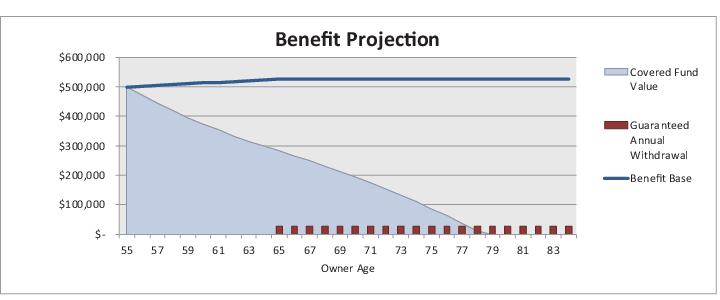Example of Ratchet Date Adjustments during the Accumulation Period
Assume the following:
Benefit Base on Election Date (of January 2) = $100,000
Covered Fund Value on Election Date = $100,000
Increase in Covered Fund Value due to Dividends and Capital Gains paid July 1 = $5,000
Covered Fund Value on July 1 = $105,000
Benefit Base on July 1 = $100,000
No other Contract Contributions, Dividends, or Capital Gains are paid for the rest of the year.
Covered Fund Value on January 2 of the following year = $105,000
So, because the Covered Fund Value is greater than the Benefit Base on the Ratchet Date (January 2 of the following year), the Benefit Base is adjusted to $105,000 effective January 2.
Excess Withdrawals During the Accumulation Phase
Because the GLWB is held in the Account, the GLWB Participant may make withdrawals or change the GLWB Participant’s Account investments at any time and in any amount that the GLWB Participant wishes, subject to any federal tax limitations or Retirement Plan limitations. During the Accumulation Phase, however, any withdrawals or Transfers from the GLWB Participant’s Covered Fund Value will be categorized as Excess Withdrawals. Any withdrawals to satisfy the GLWB Participant’s required distribution obligations under the Code will be considered an Excess Withdrawal if taken during the Accumulation Phase.
The GLWB Participant should carefully consider the effect of an Excess Withdrawal on both the Benefit Base and the Covered Fund Value during the Accumulation Phase, as this may negatively affect the GLWB Participant’s future benefits under the Contract, or result in termination of the GAWs and the Contract. In the event the GLWB Participant decides to take an Excess Withdrawal, as discussed below, the GLWB Participant’s Covered Fund Value will be reduced dollar-for-dollar in the amount of the Excess Withdrawal. The Benefit Base will be reduced at the time the Excess Withdrawal is made by the ratio of the Covered Fund Value after the Excess Withdrawal reduction is applied.
Accordingly, the GLWB Participant’s Benefit Base will be reduced by more than the amount of the withdrawal when the Benefit Base is greater than the Covered Fund Value, which is likely to occur after periods of negative market performance. This could also result in termination of the Contract and the GAWs.
Example of Effects of an Excess Withdrawal taken during the Accumulation Period
Covered Fund Value before the Excess Withdrawal adjustment = $50,000
Benefit Base = $100,000
Excess Withdrawal amount: $10,000
So,
Covered Fund Value after adjustment = $50,000 - $10,000 = $40,000
Covered Fund Value adjustment = $40,000/$50,000 = 0.80
Adjusted Benefit Base = $100,000 x 0.80 = $80,000
Types of Excess Withdrawals
All Distributions and Transfers during the Accumulation Phase, including Transfers from the Covered Fund to other investment options, are treated as Excess Withdrawals. An Excess Withdrawal will reduce the GLWB Participant’s Benefit Base and Covered Fund Value. A Distribution occurs when money is paid to the GLWB Participant from the Covered Fund Value. A Transfer occurs when the GLWB Participant transfers money from the Covered Fund to another investment. If the GLWB Participant Transfers any amount out of the Empower SecureFoundation® Balanced Fund after the Guarantee Trigger Date, then the GLWB Participant will be prohibited from making any Transfers into the same Covered Fund for at least ninety (90) calendar days.
Note: The Contract does not require us to warn the GLWB Participant or provide the GLWB Participant with notice regarding potentially adverse consequences that may be associated with any withdrawals or other types of transactions involving the GLWB Participant’s Covered Fund. The GLWB Participant should carefully monitor his Covered Fund, any withdrawals from his Covered Fund, and any changes to the GLWB Participant’s Benefit Base. The GLWB Participant may contact us at (866) 317-6586 for information about the GLWB Participant’s Benefit Base.


